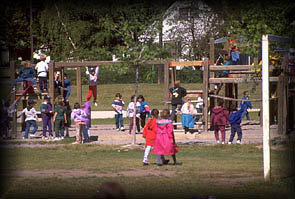

Why is it that in the latter part of the twentieth century we have provided constructed outdoor environments for children? Have the play patterns of children changed so substantively over the past century that we need to direct children's activities in an area in which they are instinctively competent? The answer is no. The play patterns of children today are exactly what they were one hundred years ago. The goal of children's play should be to foster social, physical, emotional and cognitive development, which in turn should produce healthy, full-functioning adults. We must consider playing to be learning. This axiom rings true regardless of cultural or societal differences. The ways in which a society meets the needs of its children in the outdoor environment has evolved just as the structure of society itself has undergone change.
Children's play in the early part of the century was not generally a designated event as it is today. Few formal play spaces existed when the majority of the world's population lived in rural areas. A child's experiential learning and skill development was achieved through daily contact with family, work and nature. Climbing trees, playing in puddles and running through farmer's fields, coupled with strong inter-generation relationships challenged children to reach their potential and to determine their place among others.
During the second half of the twentieth century there was a major shift in the world's population from rural communities to urban centres. Today, most of the world's children are born and grow up surrounded by human-built environments. The modern city environment is a metal, concrete and glass world - a hard world of straight lines and angles in shades of brown and grey. A child's exposure to nature is limited to those natural elements which are allowed to survive in cities. As urban centres grew and as the family unit developed, time and space for recreation and family-oriented pastimes became "activities" to fit into an ever-decreasing amount of leisure time. Planned neighbourhood parks, green spaces, recreational facilities, manufactured playground equipment and compact, fenced yards became "selling" tools with which to entice families to the suburbs. We have compensated for the loss of free-flowing, boundless play opportunities lost in rural environments by carefully constructing areas which approximate the same experiences for children. Organized sports, the provision of carefully designed play environments, access to nature and interaction between people regardless of age, sex or ability are vital concerns which if addressed properly will facilitate the healthy development of children through play.
In the 1990's, we strive to design play environments which will have a positive influence on our children's development. Exciting, diverse play areas stimulate and support children within the context of neighbourhood, community and culture. Childhood experiences from the early part of the twentieth century have shown us that natural elements such as water, earth, climate, texture, colours and materials can be thoughtfully incorporated into children's play to provide an experiential base to carry children forward effectively in adulthood.
Kathy McKee Flaherty is a Children's Play Consultant with Kompan Creative Playscapes Inc.